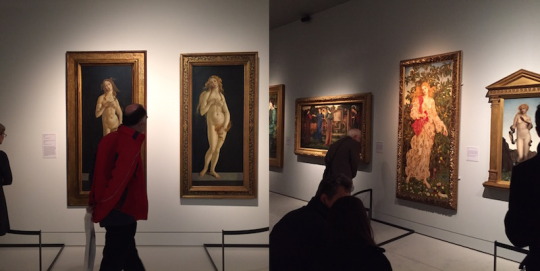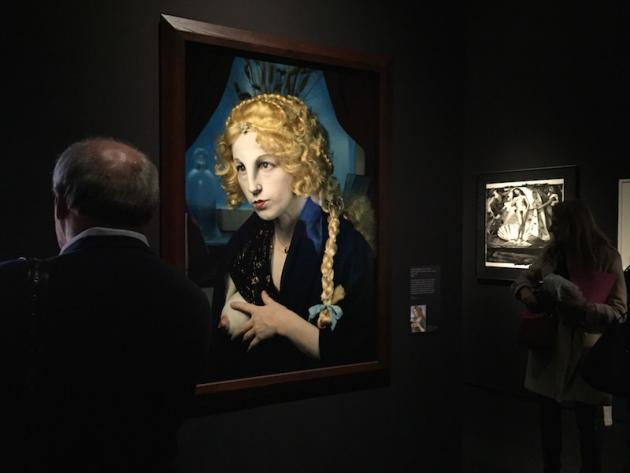Not long after the National Gallery’s opening of Delacroix and the Rise of Modern Art, here is another exhibition showing an iconic artist’s influence on subsequent generations. However, unlike the Delacroix, with Botticelli Reimagined at the Victoria and Albert Museum the very title suggests what to expect and so there is no disappointment involved.
At the outset, the exhibition is very playful and like the Pinter play Betrayal, is laid out in reverse chronological order. The visitor is greeted by a video showing popular culture filmic references to the Birth of Venus first in the form of Ursula Andress coming out of the sea complete with conch shell to greet Sean Connery’s James Bond in Dr No, followed by Uma Thurman’s rendition of the Birth of Venus in Terry Gilliam’s The Adventures of Baron Munchausen. I’m surprised they didn’t go one step further and use Gilliam’s animation of Venus dancing for Monty Python.
The exhibition is divided into three sections each with its own design identity. The first shows how Botticelli influenced and informed present day artists and is presented in the typical V&A mode of black walls and glass showcases. Botticelli’s images of Venus and Primavera are synonymous with youth, beauty and gracefulness. Yet, the examples chosen verge on the kitsch from Jeff Koons album cover for Lady Gaga’s Artpop, David Lachapelle’s gaudy Rebirth of Venus, Dolce and Gabbana’s Venus dress littered with images of the famous painting or Andy Warhol’s close up of Venus’s face from his series Details of Renaissance Paintings. Other examples are taken from film, fashion, photography, performance as well as painting. Cindy Sherman’s humorous offering from her History portraits series based on Botticelli’s Allegorical Portrait of a Lady is a more thoughtful homage as is Yin Xin’s Venus with dark hair and oriental features who challenges the western perception of beauty. Schiaporelli’s embroidered Evening Dress is a more elegant homage. There is a breadth of influence from Augustus John, Magritte, Rauschenberg to Orlan’s performance pieces and Bill Viola’s video piece.

The second section takes us back to the 19th century when Botticelli began to be rediscovered. Here the walls are painted a pale grey and the exhibition takes on a different vibe. Rather than the 20th and 21st centuries obsession with The Birth of Venus, 19th century artists were more taken with Primavera. The Pre-Raphaelites dominate this section with works by Dante Gabriel Rossetti and Edward Burne-Jones. Rossetti’s La Ghirlandata contains Botticelli’s aesthetic sensibilities; Burne-Jones’s The Mill: Girls Dancing to Music by a River reworks the three graces from Botticelli’s painting and William Morris’ large tapestry The Orchard is clearly influenced by the earlier master’s flowers. Botticelli’s presence was also in the symbolist works of Gustave Moreau and in the Neo-classical Ingres.
Having seen the impressions Botticelli made on subsequent generations, the final section takes us all the way back to the Renaissance and the works of Botticelli and his workshop. The walls are painted even lighter here in cream, which contrasts with the seriousness of the subject matter. Religious paintings dominate with nativity scenes, the Annunciation, Virgin Mary and child and Jesus on the cross. There are a series of tondi; drawings from Dante’s Divine Comedy and portraits of Florentines including the Medici family and other figures. Both young men and women are presented with his idealized beauty. There is the National Gallery’s full-faced Portrait of a Young Man and the profile portraits Ideal Portrait of a Lady and Allegorical Portrait of a Lady (that Cindy Sherman Cindy Sherman referenced earlier in the exhibition). Both Primavera and The Birth of Venus are too fragile to travel but the Uffizi has loaned Pallas and the Centaur. Pallas is painted with the Venus’ serenity and flowing hair while her dress has the floral detail of Primavera. There are also two monumental female nudes of Venus painted on a black background striking the same pose as the more famous version. However, there are too many works from his workshops which do little for his reputation.
If the exhibition was billed as being just the work of Botticelli it might have mattered that the two best known works were absent. However, as the images of the two works had dominated the previous sections it became a treat to see that there was another side to him and to see just how many Botticellis were actually in the show. Maybe they could pull off this presentation because it was the V&A and not the National Gallery.
Words/Photos Sara Faith © artlyst 2016 Top Image: Cindy Sherman Untitled 225 1990

